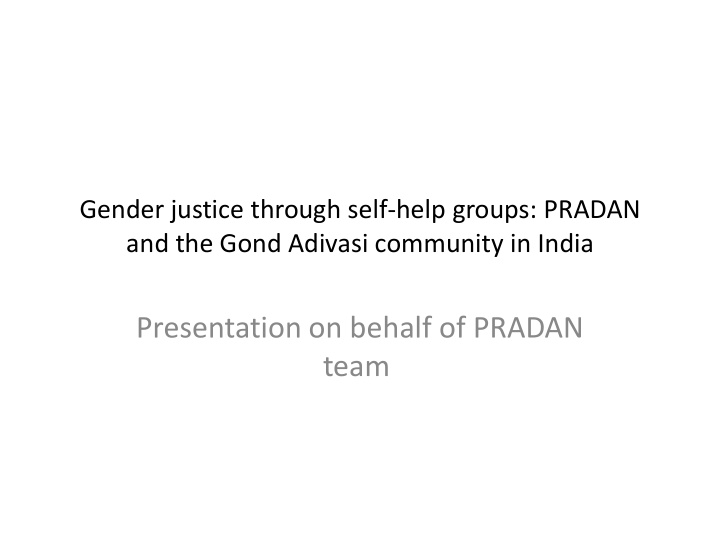



Gender justice through self-help groups: PRADAN and the Gond Adivasi community in India Presentation on behalf of PRADAN team
Team Members • Nivedita Narain is Senior Fellow at the Centre for Development Practice, Ambedkar University Delhi and concurrently working as Programme Director in PRADAN. She has 3 decades of experience of working with Civil Society in India, especially in the area of women and gender, having established India’s first SHGs, livelihoods, organisation development and human resources management and research. She currently leads PRADAN’s initiative to work closely with the higher education sector, to introduce Development Practice as a new profession in India. • Varnica Arora is an Executive, working with PRADAN. She completed her Masters in Psychology from the University of Delhi. For the last eight years she has been working with institutions of poor women from marginalized adivasi communities across rural India. At present, she is based out of PRADAN’s team at Bhanupratappur in Kanker, India, where this research will be conducted. • Vinitika Lal is a psychologist by training and a consultant with PRADAN. She has been working with young people and educators on building social responsibility with a focus on bringing educated youth to work with marginalized rural communities with a commitment to end poverty in India. She is also a facilitator of women's peace circles, for Creators of Peace which is part of a worldwide movement of people committed to social transformation through personal change. • Naila Kabeer is Professor of Gender and Development with the Department of International Development and the Gender Institute, London School of Economics. She has worked with PRADAN in the past
PRADAN (Professional Assistance for Development Action) • Founded in 1983 • Ethos of professional support to poor people rather than charity and good intentions. • PRADAN professionals divided into 32 teams, have worked with over 271,000 families in 5,000 villages across seven of the poorest states in the country. A majority of the families that PRADAN works with are adivasis (Scheduled Tribes) and dalits (Scheduled Castes)
Adivasis make up around 8-10% of the population in India. There was an increasing concentration of adivasis in poorest wealth deciles between 1993 and 2005 % of the poorest who were adivasi: In 1993, % of the adivasi population among the poorest 22% of the poorest decile and just 1.7% of the In 1993, 25% of adivasi population was in richest were adivasis. In 2005, they made up poorest decile and 2% in the richest. In 2005, 25 percent of the poorest decile, signifying a 30% were in the poorest decile and just 2% in widening wealth gap richest DECILES 1993 1998 2005 1993 1998 2005 1 st 0.223 0.217 0.251 0.253 0.245 0.297 2nd 0.132 0.148 0.167 0.149 0.167 0.198 9 th 0.030 0.031 0.027 0.034 0.035 0.031 10 th 0.017 0.015 0.017 0.020 0.017 0.021
From 3rd to 4 th transition • One of the findings of the study by Kabeer and Noponen (2005) was that despite the economic improvements brought about by the SHG approach, particularly in combination with livelihoods training, the organization had not managed to build women’s capacity for voice and influence, both among within their own communities and in relation to the wider society. The understanding of poverty as lack of income, capital, technology and knowhow has therefore undergone significant changes over the years. A key realisation was that despite their enhanced incomes, there was a lack of confidence among SHG women from marginalized communities in shaping the development discourse in their areas and gaining a sense of control over their own lives. The 4 th transition starting in 2010 was to bring concerns with gender justice more centrally into the • organization. It piloted a collaboration with Jagori, one of longest-standing feminist organizations in India, to specifically addressing gender inequality and enhancing women’s voice and agency across 9 selected districts in Jharkhand, Odisha and Madhya Pradesh. This was funded by UN Women • An evaluation conducted 2014 pointed to a deeper understanding of gender inequality amongst the women: shifts were clear in terms of increased participation in local village forums and petitioning; mobility in the public domain and recognition of equality of treatment between boys and girls. BUT impact on domestic violence, power relations within the household and access to public goods post petitioning remain unclear.
Next transition? • This region was earlier the Bastar district but is now divided into seven districts namely Upper Bastar Kanker, Narayanpur, Dakshin Bastar Dantewada, Sukhma, Bastar, Kondagaon and Bijapur. All the districts belonging to this region feature among the 150 most backward districts of India (Planning commission of India, 2010 ). There is a strong Naxalite presence but they leave us alone as we present ourselves as non-partisan. • The proposed study is located in Upper Bastar Kanker district which ranks 12th out of 16 in the state on the Human Development Index with an abysmal score of .391. • We have been working in this region with Gond adivasis since 2008-09. • The women in these communities are located at the intersection of caste, gender, income and spatial inequalities. Along with their struggles for livelihoods, they must cope with restrictions on mobility, lack of voice, domestic violence and heavy workloads. This are issues we would like to work on but we propose to address them through the joint analysis of problems and co-construction of solutions.
The next transition? Resilience of inequalities lie in the asymmetries of power within the community which are not only culturally sanctioned but also internalized as essential to self and community identity. We are therefore proposing to move beyond generalized ideas about gender inequality and to locate it within adivasi life worlds. We believe that inequalities can be better understood and addressed if they are embedded in the everyday lives of communities and as part of processes of change based on critical reflection on their own societies
Recommend
More recommend